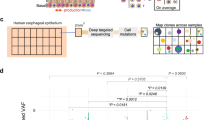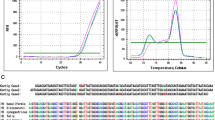Abstract
Epidemiological evidence suggests that alcohol intake, use of tobacco, ingestion of mycotoxins and nitrosamines and nutritional deficiencies are high-risk factors for the development of oesophageal cancer. Similarly, viral infections have been postulated to play a role in some tumours. However, the molecular events underlying the development of oesophageal carcinoma are poorly understood as yet. Loss of p53 tumour-suppressor gene function has been found in different human malignancies, and it can occur in a variety of ways, including gene mutation and interaction with the E6 protein of oncogenic human papillomaviruses (HPVs). Because the oesophageal mucosa is potentially exposed to mutagens and HPVs, we studied DNA samples derived from nine HPV-positive squamous cell carcinomas and 12 HPV-negative tumours. Exons 5-9 of the p53 gene containing phylogenetically conserved domains were examined using the polymerase chain reaction-single-strand conformation polymorphism (PCR-SSCP) technique. HPV detection was done using DNA in situ hybridisation with biotin-labelled HPV DNA probes. Mutations were detected in eight (38%) out of the 21 cases. Three mutations were found in exons 5/6, three in exon 7 and two in exon 8/9. Six (50%) of the 12 HPV-negative carcinomas showed p53 mutations. Two (22.2%) of the nine HPV-positive carcinomas were found to contain p53 mutations as well; one contained HPV 16 DNA sequences and showed p53 mutation in exon 8/9, and the other was HPV 6/11 positive with the mutation in exon 5/6. Although mutations were more common in HPV-negative tumours (50.0% vs 22.2%), the difference in p53 mutations in HPV-positive and -negative tumours did not reach statistical significance (P = 0.1946). These data indicate that inactivation of the p53 gene is a frequent event in oesophageal squamous cell carcinomas and such an inactivation might be an important molecular pathway for the development of oesophageal cancer. The findings of p53 mutations in HPV-positive oesophageal carcinomas suggest that HPV and p53 mutation were not mutually exclusive events. The presence of frequent mutations of p53 gene in both HPV-positive and -negative oesophageal carcinomas suggests a dominant role of environmental carcinogens in oesophageal carcinogenesis.
This is a preview of subscription content, access via your institution
Access options
Subscribe to this journal
Receive 24 print issues and online access
$259.00 per year
only $10.79 per issue
Buy this article
- Purchase on Springer Link
- Instant access to full article PDF
Prices may be subject to local taxes which are calculated during checkout
Similar content being viewed by others
Author information
Authors and Affiliations
Rights and permissions
About this article
Cite this article
Chang, F., Syrjänen, S., Tervahauta, A. et al. Frequent mutations of p53 gene in oesophageal squamous cell carcinomas with and without human papillomavirus (HPV) involvement suggest the dominant role of environmental carcinogens in oesophageal carcinogenesis. Br J Cancer 70, 346–351 (1994). https://doi.org/10.1038/bjc.1994.305
Issue Date:
DOI: https://doi.org/10.1038/bjc.1994.305
This article is cited by
-
Human papillomavirus (HPV) types 16 and 18 infection and esophageal squamous cell carcinoma: a systematic review and meta-analysis
Journal of Cancer Research and Clinical Oncology (2021)
-
The role of human papillomavirus in the pathogenesis of head & neck squamous cell carcinoma: an overview
Infectious Agents and Cancer (2011)
-
HPV & head and neck cancer: a descriptive update
Head & Neck Oncology (2009)
-
Human papillomavirus E6 and E7 oncoproteins as risk factors for tumorigenesis
Journal of Biosciences (2009)
-
Profiling early head and neck cancer
Nature Reviews Cancer (2005)



